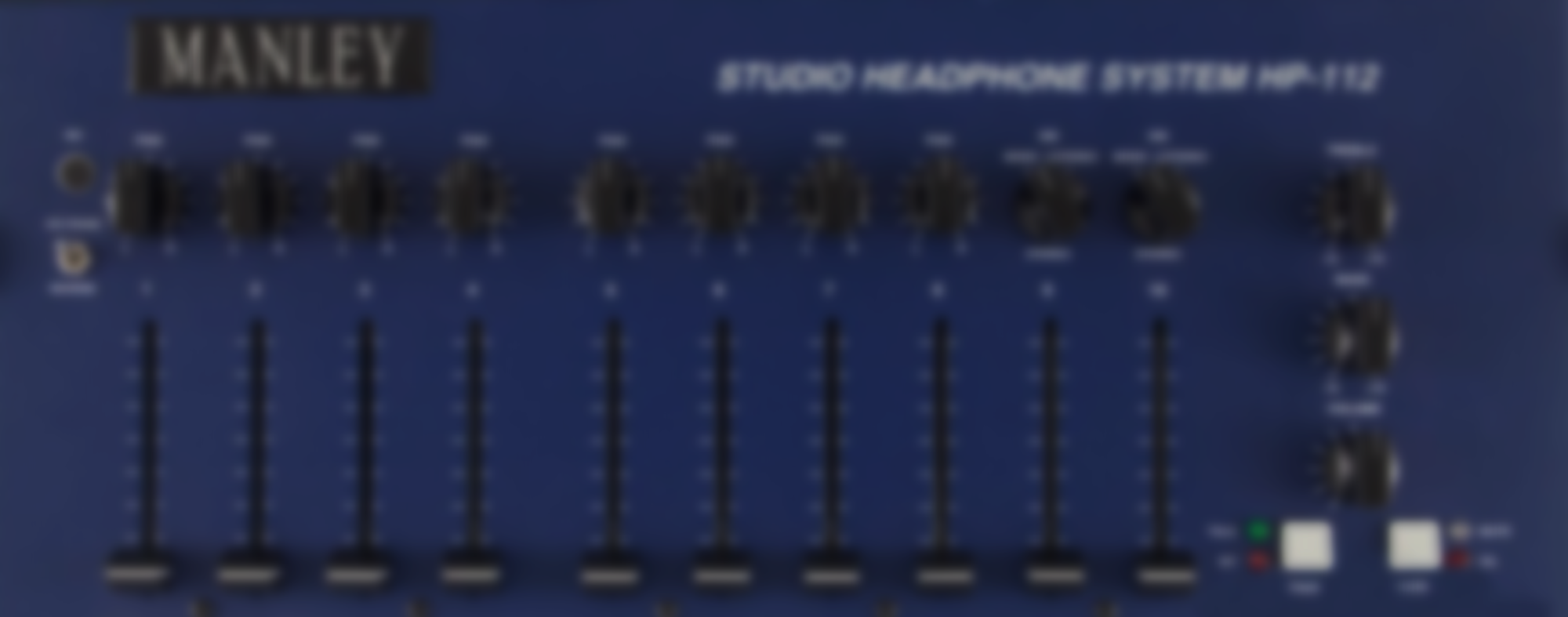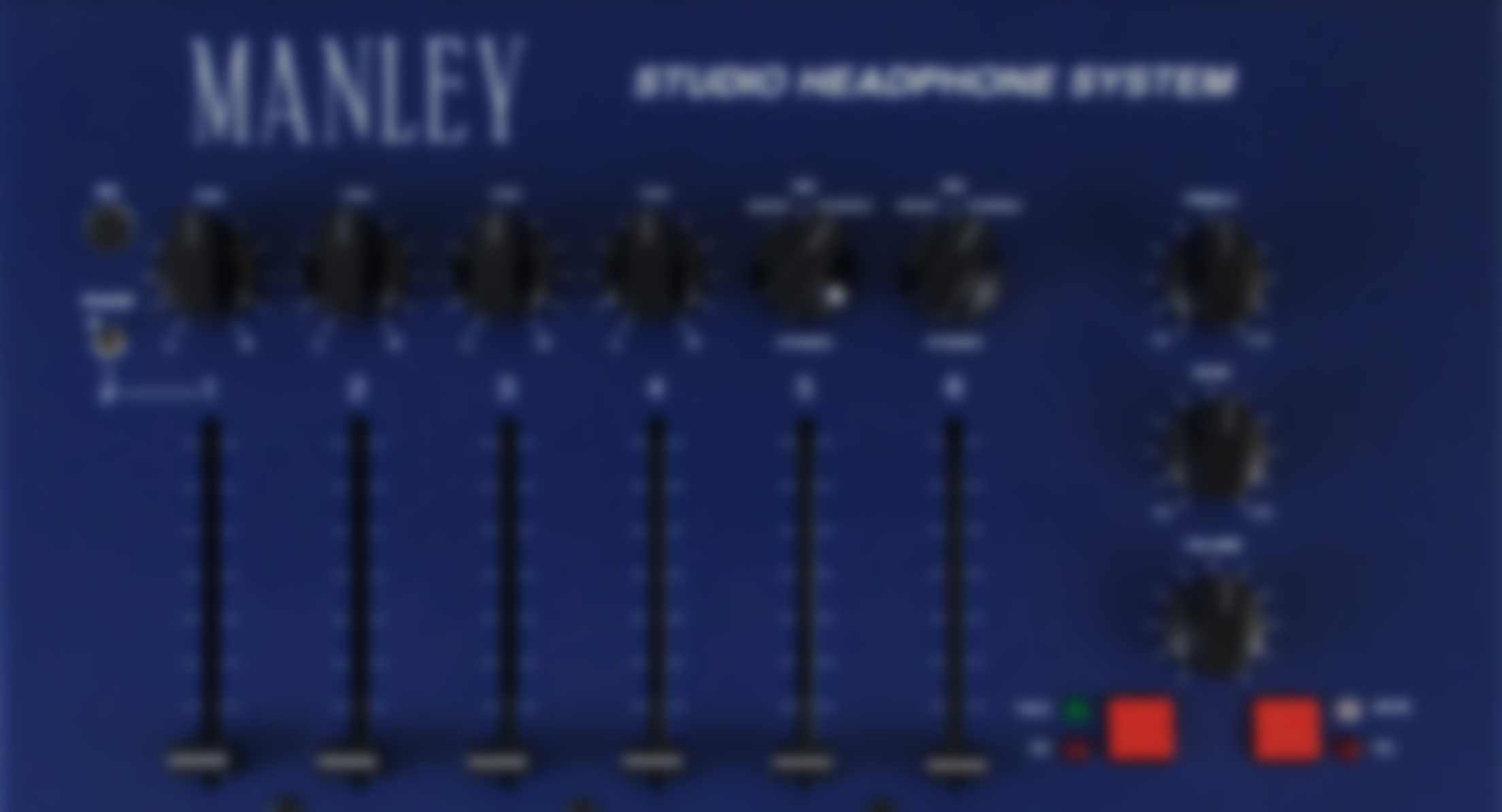
Back by popular demand - and now in the Manley stable.
We subtitle this unit "THE MORE ME BOX" because this is possibly its most important feature. Along with the typical cue mix or the control room mix, the engineer can offer each musician a fader dedicated to their own instrument. Experience teaches us that each musician always wants to hear more of themselves and that trying to meet this demand with several musicians and with too few aux sends is quite a mind bending challenge. As long as each musician's headphone is plugged into a separate station, each can have their own custom mix within arms reach. This frees up the engineer to concentrate on recording and getting the best sound and allows the producer to focus on performances because the musicians' monitoring needs are met quickly and easily. It also frees up console aux sends so that they may be used for effect sends. With this station you will be able to offer musicians a better sounding headphone amp than most major studios and be able to provide some significant improvements over basic stereo cue boxes or any other headphone system we know of.

DETAILS
Each HP-112 station provides 12 x balanced inputs: eight mono channels with FADER and PAN plus two stereo feeds with rotary switches providing stereo, mono and SIM processing. This cool SIM setting monos the bass which makes it sound more like listening to real speakers.
Channel one has a PHASE switch, intended primarily for the vocalist. Voice is heard through the bones in the head as well as the phones. You may not hear much difference switching the phase in the control room but the person at the mic certainly will. Polarity gets inverted all the time in studios which may explain why sometimes the vocal is so loud in the phones or sounds different on playback to the singer. Our PHASE switch sure does come in handy.
All of the channel inputs appear on ELCO multi-connectors, wired to ADAT standard, making linking or daisy-chaining several stations easy. See ELCO pinout here. We approach cable making as a custom order which means prices depend on length and quantity and connector choice. Please contact us for a factory quote.
The Mute controls the Power Amps directly and steps through ON, MUTE, LEFT MUTE and RIGHT MUTE then back to ON. This is such an important feature! By muting one channel, if the musician wants to put one can on his head, sound from that speaker won't be leaking into your overheads! Each station also has bass and treble EQ controls carefully optimized for headphones. The master stereo volume control feeds the built-in power amps which produce peak voltage (equivalent to) well over a hundred watts per channel to drive up to 4 headsets at any volume the musician may choose. No weeny little beetles like you'd find in your iPod here!
The two features that impress the musicians the most are the easy communication with one button and the fabulous sonic quality even at extreme levels. Ever clever, the ELCO connectors also provide pins used for several other communication and monitoring functions, including TALK and INTERRUPT. There are also hidden features on the ELCO's such as the ability for the control room to monitor each stations' headphone mix or the to hear the unswitched "always-on" individual station microphone.
See installation and wiring notes of advanced features here. The Manley cue mixers are versatile systems, to be sure.
SPECIFICATIONS
INPUTS: All inputs on ELCO/EDAC 56-pin connectors 40 kOhm input Z
Channels 1 - 8: Balanced line-level mono with 60 mm fader and pan pot
Channels 9 - 10: Balanced line-level stereo with 60 mm fader switchable Mono, Stereo or Stereo Image Manipulation (SIM)
CMRR greater than 70dB with source Z< 150 Ohm
HEADPHONE OUTPUTS: Four 1/4" stereo headphone jacks connected in parallel
Peak to peak voltage: typically 50 volts into 100 Ohms
Power output: 3 watts RMS into any load from 4 to 100 Ohms
Output impedance less than 0.1 Ohm
Built-in protection against overvoltage, undervoltage, overloads, shorts to the supplies or outputs, thermal runaway, and most other catastrophes.
No power-down / power-up thumps, pops, or DC
Multi-mode MUTE button ("panic button")
THD + Noise: < .03% (-70dB)
Tone controls > ±12 dB @ 100 kHz & 10 kHz (gentle slope)
COMMUNICATION: Multimode TALKBACK. "TALK" over music, "INTerrupt" kills music
DC control voltage enables individual stations to receive TalkBack signal
Built in MIC and TALK button, 2 LEDs show TalkBack mode
MIC and SWITCHED MIC signal available via ELCO input
POWER SUPPLY:
Dedicated external PSU per station.
Power consumption (120/240VAC): 13 watts
Factory set for 100V, 120V or 220-240VAC operation for original destination country's mains voltage.
Operating Mains Voltage changeable with power transformer re-wiring via switch and fuse value change.
Mains Voltage Frequency: 50~ 60Hz
GENERAL INFO:
Dimensions: 16" x 7 3/4" x 2 1/2"
HP-112 Dimensions: 16" x 7 3/4" x 2 1/2" are as follows:
16 inches Width
7 3/4 inches Depth (Which includes rear protrusion of rear-mounted ELCO connector. Otherwise, it's 7 inches Depth excluding ELCO connector depth rear protrusion.)
2 1/2 inches Height (Which includes upward protrusion of knobs. Otherwise, it's 2 inches Height excluding knob height upward protrusion.)
Shipping Weight: 9 lbs.
TECH HINTS for LOWEST NOISE:
They like balanced power from the Equitech.
Opening up the faders more so than the headphone amp's volume knob can keep the hum below the source noise floor.
High impedance headphones work well.
Optional accessories available for the HPA-112
Daisy-chain cable to link additional systems. Custom lengths could be ordered.
Mic stand adapter swivel bracket $40.00 USD

DOWNLOADS
HERE'S A COOL THING
Bob over at Sound Anchors custom-fabricated these massive heavy duty stands for a client's HP-112 12-channel mixer. See how he integrated the power supply mounting onto the base of the stand. Very clever! I am sure he would love to sell more of them so if that turns you on, go chat with Bob over at Sound Anchors. He also makes superb amplifier and speaker stands as well as equipment racks.
MORE WIRING NOTES
The Manley HP-112 Headphone Mixer (12 Channel) unit is $2,200 each with PSU. All features are the same as the HP-101 8 channel model except there are 4 more mono inputs. Yes, the HP-101 8 channel units and the HP-112 12 channel units can be mixed in the same installation as far as the ELCO cabling is concerned however, the 8 channel units won't receive signal channels 9-12 from the 12 channel units. (Duh.) All the rest of the functions (talkback, logic, Interrupt, Mic etc.) are 100% compatible between both models. See HP-112 ELCO pinout here.
The logic is based on a spare op-amp that is tricked out so that when the two lines (Elco a & b) are simply shorted, the TALK function is engaged. This was intended for footswitch and box-to-box operation mainly.
Alternatively each line (Elco a or b) can be shorted to ground to enable TALK or INTERRUPT. This method is pretty easy to interface either with relays or a dedicated hard-wired switch.
The last alternative gets a bit trickier, and relies on a differential voltage applied to a and b. Can be thought of as "If a is (significantly) more positive than b then INTERRUPT", "If b is (significantly) more positive than a then talk", "If both are similar then do nothing. This mode might be considered a differential comparator. If I remember that far back, it should work with standard 5V logic and definitely does with 9-15 volt, and suggest static protected 3-state buffers or open collector transistor logic for reliability.
We were planning to offer an "control room interface box" but nobody requested one, so ......
Reading between the lines, there is some DC on both lines, which fouls the idea of straight TTL 2 state control (0volt). And if memory serves, a little experimentation goes a long way, because there seemed to be lots of ways to control either or both of those states, and awfully damn difficult to blow something up re those 'logic' lines.
Of course we could have used an 'iso-oplitator' and schmitt, standard logic levels, etc and dressed formally but we were a low-tech operation 12 years ago, and had near zero board space left, and it was significantly over-budget already, so snuck in this bogus remote circuit for a few resistors and it works fine.




